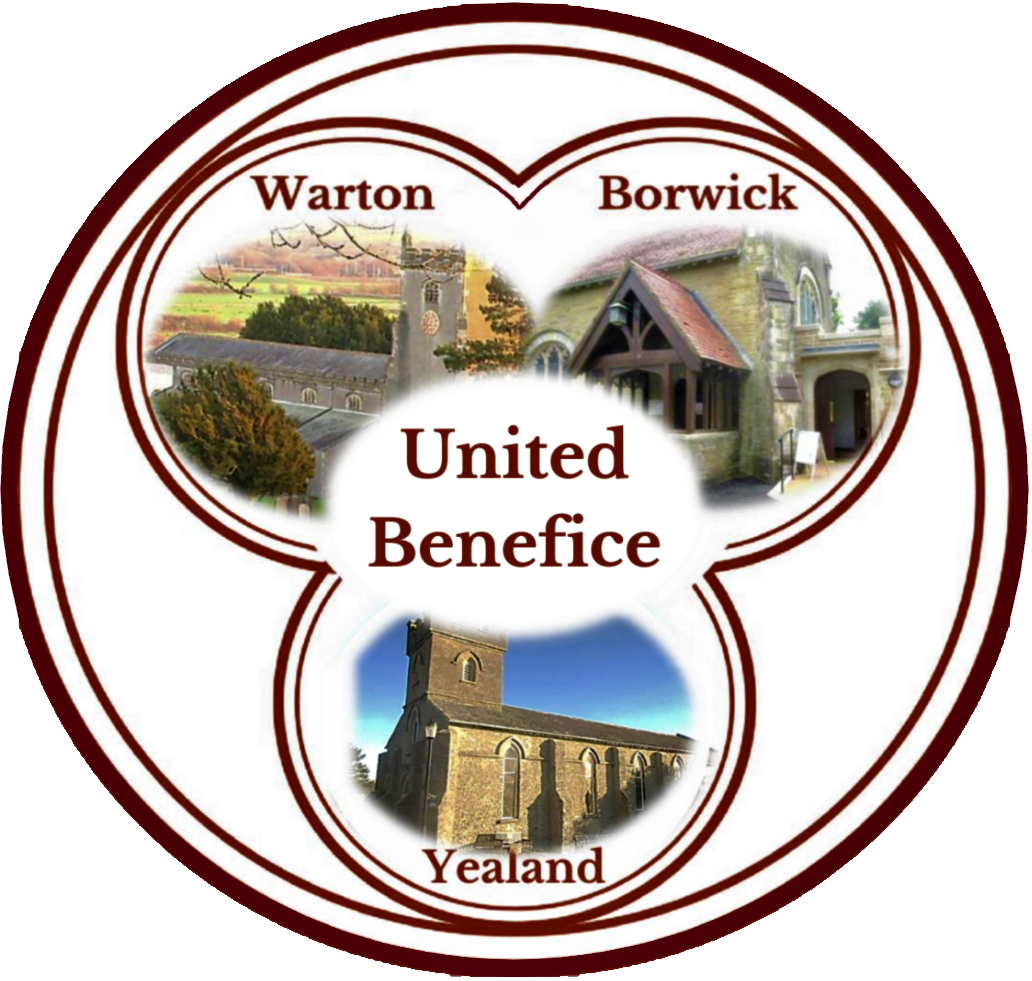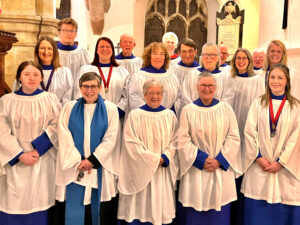The Choir was reformed in 1980 by Paul Winter and has worked hard to gain the current standard of singing. We rehearse twice a week and lead the singing at the Sunday 9.30am service among others.
Our music ranges from classical church period music to modern composers and songs. We are currently 24 members and we welcome all singers; young and old, male and female.

St Oswald and George Washington
Warton Church is dedicated to Oswald, warrior king and one of England’s favorite saints before the Norman Conquest. He was born about the year 605 A.D., at a time when the English nation was a loose confederation of often warring tribes. He died in battle and his vanquisher, King Penda, caused his body to be savagely dismembered. The head, arms and hands were severed and fixed on a stake, probably the “tree” that survives in the place named Oswestry (Oswald’s Tree). His death was seen as martyrdom and the barbaric treatment of his remains would be linked in the mind of Christians at that time with the humiliation of the crucified Christ less than 700 years earlier.
Warton Church also has an historical link to the George Washington family and receives many visitors from the UK and oversees to explore the connection.
St. Oswald’s Church has long been associated with the Washington family and over the years has received many American visitors wanting to visit a part of this country associated with their first president, George Washington.
The Washingtons, or de Wessingtons, were a Durham family who acquired lands in the county of Westmorland and then in north Lancashire. There are references in wills, deeds and settlements throughout the 14th and 15th century to Kerneford (Carnforth), (Over) Kellet, (Priest) Hutton, Heysham, Tuetffylde (Tewitfield), Silverdale and Warton involving members of the Washington family.
John de Wessington seems to have been the first member of the line to settle in Warton. Then followed three generations of Robert Washingtons. The Washington family tree is displayed in the north aisle of St. Oswald’s. Also displayed is the family tree of Sir Winston Spencer Churchill who is related to the Washingtons through the Kitson family of Warton.
The third Robert Washington had a son John with his first wife Elizabeth Westfield, and this son married Margaret Kytson of Warton Hall. Their son Lawrence, presumably born in Warton, then appears in Northamptonshire as a wealthy wool merchant, purchasing Sulgrave Manor. This house, remained in the possession of the Washington family for three generations.
Through his son Robert and grandson Lawrence, Lawrence Washington of Warton is the ancestor of Colonel John Washington, who emigrated to Virginia in 1656, and so of President George Washington.
The earliest known example of a Lancashire Washington seal is a Duchy of Lancaster deed dated 1401 in the Public Record Office in London. In St. Oswald’s church tower, reputed to have been built by a Robert Washington of Warton, you will find an eroded stone seal consisting of two bars and three mullets in chief on a shield, exactly as described above. This stone was formerly on the outside west wall of the tower but was brought indoors to preserve it. The Washington seal is believed to have inspired the modern flag of the United States consisting of stars and stripes.
Other members of the Washington family remained in Warton and the surrounding area for several generations, some of them taking holy orders. The last member to live in Warton was the Rev. Thomas Washington, Vicar of the parish (inducted in 1799). He died on 7 February 1823 aged 69. His grave is the only Washington tombstone visible in St. Oswald’s churchyard, though many other members of the family must lie buried there. Much eroded it stands against the east wall of the church and bears the inscription:
Mrs. Elizabeth Washington
June the 15th 1751
THOMAS WASHINGTON
Clericus hujius Ecclesiae Vicarius
obiit die Septimae Feby
MDCCCXX111 aetatis
Suae anno Sexagesimo non
Windows
The church must have had stained glass in all its windows in the Middle Ages for John Lucas, in his 18th Century description of St Oswald’s, recorded that in the early 18th century there were fragments of painted glass in all of them ‘yet not one figure or inscription entire’. He thought they should be taken down and the whole reglazed, and it seems that this happened. It was not until 1856 that glazing with stained glass began again, and within forty-five years all were filled with memorial glass. This was largely due to two families, the Boldens of Hyning, and the Sharpes of Linden Hall, Borwick, who between them gave eleven of the sixteen windows. The lion’s share of the work of making the windows was entrusted to a single stained glass firm, who made all but four. Henry Hughes (1822-83) became a partner with Thomas Ward in about 1852 and was their chief designer. He also produced windows under his own name, including some Warton windows. On Hughes’ death in 1883 a relation, T.F. Curtis, took over the firm and most of the windows were designed by George Parlby in a quite different style. We take the windows in order, starting with the East Window above the altar and moving clockwise round the church.
(1)The East Window is unsigned but is probably by Hughes. It was a memorial to John and Mary Bolden of Hyning and dates from 1856. The background is of round clear quarries and there are five figures. In the centre is Christ in the act of blessing, and he is flanked by the four gospel-writers, each with his traditional symbol – the human figure for Matthew, the lion for Mark, the ox for Luke and the eagle for John. Below are the other symbols for them, the money bag under Matthew, the palm under Mark, the pelican feeding her young with her blood under Christ, a palette and brushes under Luke, and a chalice under John. In the tracery is the Hebrew name for God JHVH, the brazen serpent and the scroll of the Law, with the prophets Isaiah, Jeremiah, Ezekiel and Daniel, Moses and Aaron and four kings, David, Solomon, Rehoboam and Josiah.
(2)The window in the south of the sanctuary is one of the latest dating from 1895. The work of Ward and Huges in the time of Curtis, it represents the meal of Emmaus after Christ’s resurrection. It was one of the five windows given in memory of members of the Sharp family all within six years.
(3-5)The three windows of the Lady Chapel. These three windows are by Henry Hughes. First is the memorial to Mary Dean, wife of the vicar, who died in 1862. It represents the virtues of faith, hope and charity. The other windows are in memory of husband and wife, William and Jane Sharp and date from 1861 and 1857. The first is of the Ascension and the parable of the Good Samaritan, the second of Christ appearing after his resurrection to Mary Magdalen and the parable of the wise and foolish virgins.
(6)The first window in the south aisle is very attractive and is undoubtably by the excellent Lancaster firm of Sgrigley and Hunt. It is in memory of two children of the Managerr of the Carnforth Iron Works. Bessie Barton died in 1871 aged 7 and William Barton died in 1883 aged 18. The subjects are the Virgin Mary being taught by her mother Anna, and Timothy being taught by his mother Lois. It is interesting to note the contents of the books, the Song of Hannah in 1 Samuel, and a Roman alphabet.
(7)The second window in the south aisle probably by Hughes, is of brightly coloured vines leaves and texts, and is in memory of Mary Walling; placed here in 1862 long after her death.
(8)The window in the choir vestry is the only one by a local maker, F.Burrow of Milnethorpe and is dated 1862. It was in his memory of Edmund Lawson, and his wife’s name was added later after his death. Burrow was born at Minlethorpe and became a plumer. He learned the art of stained glass in London. After working at Salisbury Catherdarl he returned to Milnethorpe and made windows for a number of churches in the locality. According to his obituary he was an atheist. The window with its lurid colours and course drawing represents Christ talking with the women of Somaria at the well.
(9)The windows at the end of each aisle and the first two in the north aisle date from the 1890’s campaign by Sharps to complete the church’s stained glass. All are by Ward and Hughes in Curtis’s unmistakable style, and the represent Christ blessing sufferes, the virtuos woman distributing bread to the hungry, the Crucifixion and Christ blessing children.
(10)The last window in the north aisle tells of a family tradegy, for it is in the memory of three little children, aged 7, 3 and 4 months, of the Reverand and Mrs George Berkeley (she was a Bolden). They all died at Christmas 1861. The window is by Henery Hughes and again represents Christ with children, and as the Good Shepherd. Perhaps the tradegy affected the artist for the drawing is feeble and sentimental.
(11)The window on the north of the alter is in bright colours telling of the announcement of the birth of Christ to the shepherds and is by Henry Hughes. It is in memory of Thomas Dean, who was vicar when the earlier stained glass was installed and is dated 1872.
(12)Under the Tower is one by Powell of Leeds dated 1872. The figures are those of John the Baptist and the Virgin Mary and the Latin words are: ‘Behold the Lamb of God’, and ‘Behold the handmaiden of the Lord’. It commemorates Frances Berkeley, the bereaved mother of the children who died at Christmas 1861. She died in Mentone in 1887.
(13)The window in the vestry is perhaps the most attractive of all but is now rather lost to sight. Again without doubt by Shrigley and Hunt, it represents the church’s patron St. Oswald with the Celtic saints Patrick and Aidan, richly attired with the family armorials of William Boden of Hyning who died in 1895.
(14)The Millenium Window. By 1895 every visible window was filled with stained glass and inevitably for over a hundred years there were no additions. Only one window was left but that could not be replaced as the organ hid it. Then in the 1990s it was decided to replace this instrument with a digital organ which takes up less room and the window became visible. It was suggested that it might be re-glazed in honour of the Millennium. It is in the northeast corner of what must have been a north chapel but in the 20th century it had been fitted up as a clergy vestry and a wooded screen erected. This prevents the lower part of the window being seen from the body of the church.Nevertheless, the idea was followed up and an artist from York was commissioned. York has always been a centre of the art and since the 1940s when Harry Stammers set up his studio, a number of artists have worked there. Harry Harvey worked with Stammers and Ann Southeran, after attending York College of Art, joined him and is now an associate of the British Society of Master Glass Painters. Ideas were discussed and Miss Southeran took notes. She came back with a striking design taking up the suggestion that the three lights of the window should represent past, present and future. Realising that Warton has a history, she placed in the left light the Crag with its Armada beacon. Then Archbishop Hutton and his school and almshouse; his armorials and the Washington shield tell more of Warton’s history. She noted that the ancient parish lay astride ancient and modern lines of communication between north and south, the ancient road to Scotland, the turnpike, canal, and railway, and finally the motorway. She represented this by a river which would run through all three lights. In the centre it became a scroll bearing the Millennium Resolution:
Respect for the Earth
Peace for its people
Love in our lives
Delight in the good
Forgiveness for past wrong
2000 a new start
We are very proud to have gained the Bronze Eco-Church Award and are now working towards the Silver Award.
We have a group which meets monthly to discuss what needs doing and drive forward our vision of a truly eco-friendly church.
In order to fund our work we have designed and created a tea-towel featuring a picture of the church and the Washington family crest. These can be purchased from St Oswald’s Church on Tuesday 9am -11am, Thursday 11.45am – 1.00pm (after the 11am service) and on Sunday mornings.
For more info contact Jodie Kilty on: jodiekilty@hotmail.co.uk
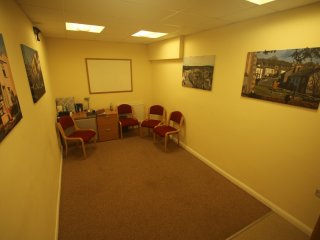
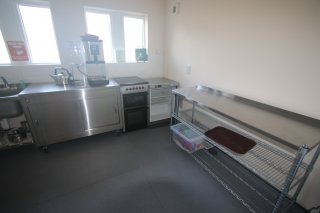
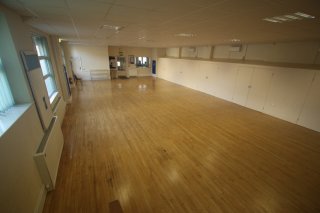
Warton Church Hall
Available to hire weekdays, evenings and weekends.
The Church Hall is a spacious venue, available for private parties, groups or classes. The hall is also equipped with kitchen and toilet facilities.
We also have a seperate meeting room situated towards the back of the hall, which is available to hire for small or regular meetings – or in addition to the Main Hall.
For more information, or to arrange a viewing, please contact Carol on 07929 283657.
Warton Church Hall, Main Street, Warton, Carnforth LA5 9PG

Every Tuesday between 9.00am and 11.00am you will find us enjoying some excellent freshly brewed coffee or, despite the name, tea! (We’ve got squash for the little ones too) We also indulge in toasted tea-cakes and delicious home-made buns and cakes.
Pop in and join us; we’re a friendly bunch and there’s no charge – just leave a donation, if you can. Everyone is very welcome; young, old and everyone in between .
And, no, you don’t have to be a ‘church-goer’! Coffee Stop is just a chance to meet up together, enjoy a good cuppa and indulge in a bun or two! Come and try it, you’ll be very welcome!
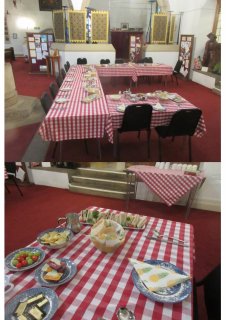
Breaking Bread meets every Thursday from 11.45am at St Oswald’s.
A simple lunch served in church for which a donation is invited.
Everyone is welcome.
Contact: Annette MacKenzie, 01524 736944.
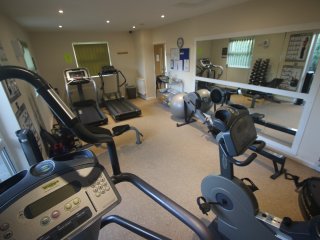
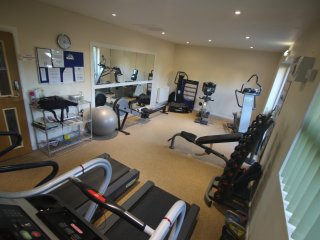
Warton Community Gym
Open 7am – 10pm Monday – Sunday.
Situated at the back of Warton Church Hall, our not for profit community gym is the best place for you to fulfil your health and wellbeing needs. We have equipment such as treadmills, weights, cross trainer, rowing machine, stepper and recumbent bicycle.
Membership Prices
| Adults | Senior (65+) | Junior 14-17 | |
| 3 months | £37 | £26 | £21 |
| 6 months | £58 | £37 | £26 |
| 12 months | £90 | £58 | £47 |
For more information, or to arrange a viewing, please call Antonia on 07761 756983, or send an email to wartoncommunitygym@gmail.com

This group meets from 7.00pm on the first Monday of each month, for a pint or two at the George Washington Public House.
Any men are welcome to imbibe in good ale, sandwiches and excellent company.
Contact: Chris Hopwood, 01524 720160.
![]()
Archbishop Hutton’s School has its origins in WARTON GRAMMAR SCHOOL, founded by Matthew Hutton. Born in 1529 and raised by his parents in modest surroundings in the village of Hutton (now Priest Hutton), Matthew was sent to study at Cambridge by a Yorkshire gentleman who recognised his potential.Graduating in 1551 he followed an academic career until the age of 40 when he entered the church, becoming first Dean of York, then Bishop of Durham and finally archbishop of York until his death in 1606.The Charter granted by Queen Elizabeth I in1595 includes the words “…shall be called henceforth in perpituity ‘The Free Grammar School and Hospital of Jesus of the town of Warton in the county of Lancaster’ to endure in future times forever.”A two storey building was erected on a site called Cross Bank to the rear of Main Street. The ground floor provided accommodation for six elderly and poor persons (from within the Ancient parish of Warton) and the Free Grammar School occupied the first floor, access to which was by an open staircase to the rear of the property. At its inception the school was equipped with a good library and the Bishop’s grant gave £20 annually to the Master and £6.13s.4d for the Usher or assistant. “Six discreet and good men” were appointed Wardens and Governors of the Free School and Hospital and all that thereto apertained. Below is an artist’s impression of the building as it probably appeared.
The school served the parish of Warton and Lindeth which in those days embraced Carnforth, Borwick, Hutton, the Yealands and Silverdale. Later in 1595 a house for the Master was added to the right hand side of the building.
As the school became more established the number of pupils increased and a boarding house was built (no. 78 Main Street) to house pupils who could not easily return home on a daily basis.The school went through several transformations as the state took an increasing interest in education.
In 1902 a new school building was erected in Main Street (now a private house). During World War II many children were evacuated to the village and the Church Hall was used as additional accommodation. The 1944 Education Act, providing free education for all, offered foundations such as Warton’s the choice of becoming Voluntary Aided or Voluntary Controlled Schools. Warton opted for the latter whereby the local authority appointed a majority of Managers (later called Governors) though the Trust founded by Matthew Hutton had representation to ensure the religious character or ethos of the school.
In 1970 the school united with a separate Infants’ School across the road and moved to its present site in Back Lane, though the older building remained in use for some time.
The school aims to be at the centre of village life, respecting its traditions, yet being at the forefront of developments in teaching and learning.
In line with most public institutions these days it has a Mission Statement, namely:
We welcome everyone, whatever your background, so that you can reach your Godgiven potential .
Its ethos statement reads: “Recognising its historic foundation the school aims to serve its community by providing education of the highest quality within the context of Christian belief and practices. It encourages an understanding of the meaning and significance of faith and promotes Christian values through the experience it
offers all its pupils.”
“The School’s aims are:
• to promote moral values, self respect and an appreciation of the Spiritual dimension of life
• to develop the academic potential of each pupil
• to develop enquiry and interest in learning
• to encourage pupils to respect and value people equally regardless of their differences
• to develop partnerships between school and the home and the local community
• to develop a joy of the value of life and a recognition of our responsibility in maintaining an ordered and caring society.”
To find out more visit the school’s web site here.
St Oswald's Church
 We welcome you all to St Oswald’s, Warton. St Oswald’s is a very beautiful church building dating from the 14th century, but there has been a church here for over 1000 years. The current building stands at the heart of the village and has served the population of Warton for over 600 years.
We welcome you all to St Oswald’s, Warton. St Oswald’s is a very beautiful church building dating from the 14th century, but there has been a church here for over 1000 years. The current building stands at the heart of the village and has served the population of Warton for over 600 years.
Warton is a fairly large village near to Carnforth, in an area of outstanding natural beauty.
We welcome many visitors to St Oswald’s, some who are walkers, others interested in our connection with the family of George Washington, still more who come to pray in the creatively devotional atmosphere of this very special place.
Beautiful though the church building is, the real beauty of the church here is our faithful congregation. We are people of mixed ages and backgrounds, and we share a commitment to welcoming in the name of Christ all who come here.
Our worship is centered on the celebration of the presence of Christ in word and sacrament, the regular celebration of the Eucharist (Holy Communion) is at the heart of our life. We enjoy a strong choral tradition, with a keen choir and a repertoire of music rarely found in village churches.
There will always be a welcome for you at St Oswald’s.
Contact Us
Rev Alice Ormondroyd
E: vicar.ubwby@gmail.com
T: 01524 956839
Map
Events & Worship Services
Calendar of Events
M Mon
T Tue
W Wed
T Thu
F Fri
S Sat
S Sun
0 events,
0 events,
0 events,
1 event,
0 events,
0 events,
0 events,
0 events,
0 events,
1 event,
0 events,
0 events,
0 events,
0 events,
0 events,
1 event,
0 events,
0 events,
0 events,
0 events,
0 events,
1 event,
0 events,
0 events,
0 events,
0 events,
0 events,
1 event,
0 events,
0 events,
0 events,
0 events,
0 events,
1 event,
0 events,
0 events,
- There are no events on this day.
- There are no events on this day.
- There are no events on this day.
- There are no events on this day.
- There are no events on this day.
- There are no events on this day.
- There are no events on this day.
- There are no events on this day.
- There are no events on this day.
- There are no events on this day.
- There are no events on this day.
- There are no events on this day.
- There are no events on this day.
- There are no events on this day.
- There are no events on this day.
- There are no events on this day.
- There are no events on this day.
- There are no events on this day.
- There are no events on this day.
- There are no events on this day.
- There are no events on this day.
- There are no events on this day.
- There are no events on this day.
- There are no events on this day.
- There are no events on this day.
- There are no events on this day.
- There are no events on this day.
- There are no events on this day.
- There are no events on this day.
- There are no events on this day.
